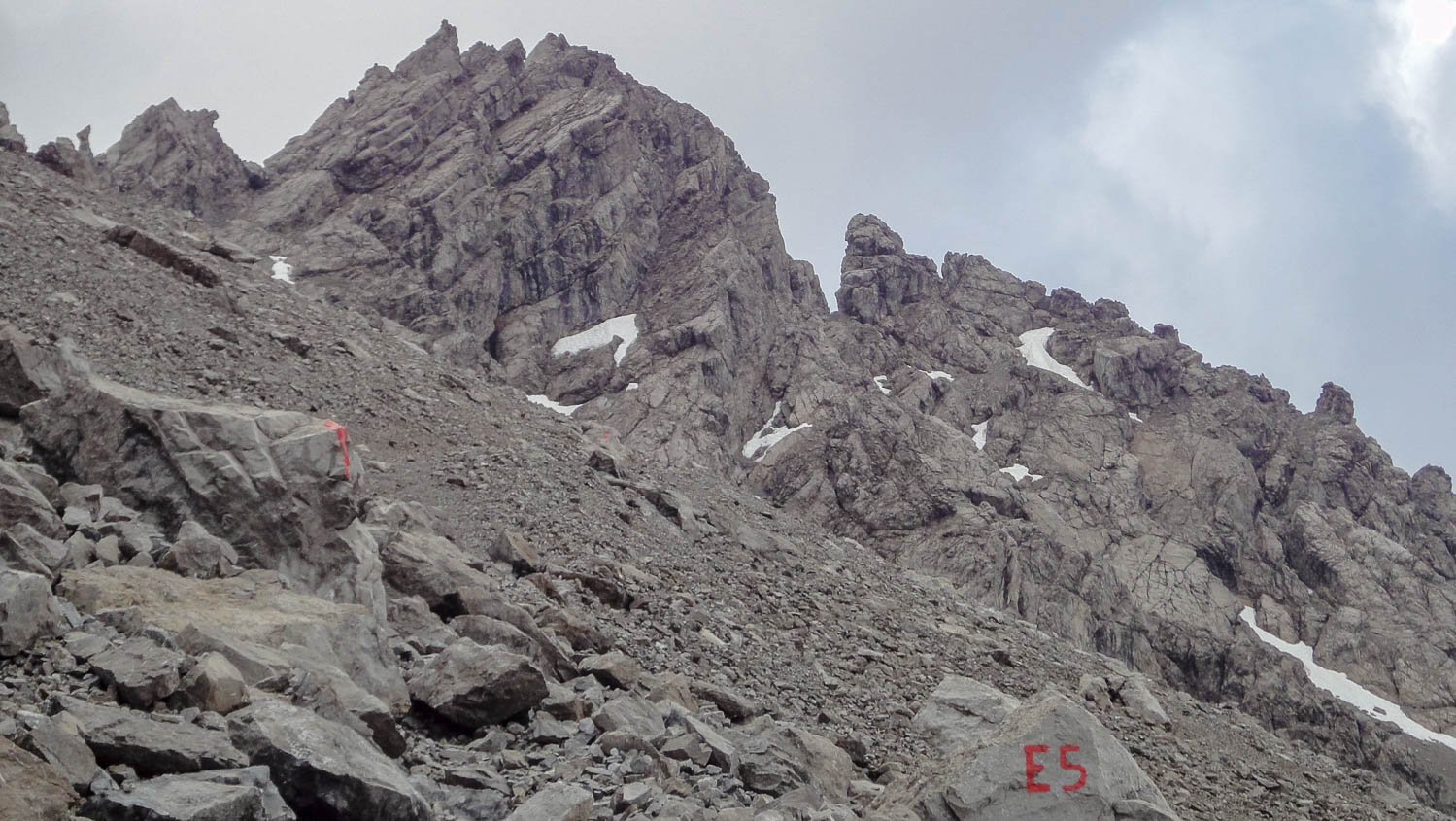For many, it is a long-nourished dream to once cross the Alps. THE classic way is the E5 from Oberstdorf to Merano. It is one on the oldest European long-distance trails. Passing paths and passes that traditionally were used to traverse the mountains between Germany, Austria and Italy.
(*Diesen Artikel gibt’s auch auf Deutsch.)
Organized or individually?
That’s a matter of preference and experience: In principle, crossing the Alps on the E5 can be done individually. If you bring the appropriate experience. If you are untrained and inexpert it is recommandable to go with an organized group. Also, if you are experienced but simply don’t want to go through the hazzle of organizing the trip yourself, you might be happy about the numerous offers of Alpine Schools and tour operators.
When is the best time for crossing the Alps?
From the middle of June to the middle of September. This is when you will find the best conditions on the path: Most of the snowpack of the last winter has gone; chances for new snow are quite little. Keep in mind: You are moving through alpine terrain. Be always prepared for weather deteriorations as well as an onset of winter.
You would like to do your tour indivdually?: If possible, NEVER – NUNCA – NIE start hiking around the weekend in Oberstdorf. With this I mean the period from Friday up to and including(!) Monday. These are the days when the organized groups of Alpine Schools and tour operators start their trips. Many hikers on the paths, long waiting queues in front of the showers, crowded rooms. – Just a few arguments for you to consider a start in Oberstdorf rather on Tuesday, Wednesday or Thursday instead.
What backpack will I need?
A volume of 30l will be best, maximum 40l. With this, you should manage without problems on your multiple day hike. The smaller, the better. – Your back and your knees will appreciate it.
If you have the chance: Buy your backpack in a specialized outdoor shop. Seek professional advice, try on different backpacks (with sufficiant loading). There are huge differences and each of you will find an own favorite. For (shorter) women, the German manufacturer Deuter has a big range of special women’s models. You can recognize them by the name addition „SL“. They especially have a shorter and smaller back. Furthermore, the hip fins as well as the shoulder straps are adjusted to the female anatomy. Unfortunately, many other manufacturers still have none to only a few special women’s models.
Don’t forget the raincover. (Check: It might be included in a separate bottom pocket of your backpack.)
I have not been yet to a hut of the Alpine Club. – What should I do at arrival?
Depending on the time of the day, there will be more or less hikers at the cabin. Probably you will arrive with other hikers or with other groups in the afternoon. Simply put your backpack aside and enjoy your arrival. After that, a common procedure is: Take off your hiking boots and put them on one of the shoe racks. Maybe you have wet clothes? In many cabins you will find a drying room. Put on your slippers. Get in touch with the cabin team. Bring your membership card – if you have one – of your Alpine Club. You will be told were you can sleep. Get your backpack and bring it to your room/dorm. It’s advisable to set up everything (take out your backpack, place the blankets) and also to refresh a bit. Thereafter, enjoy a beer or a juice, and take in the view from the panorama terrace …
Do I really need trekking poles?
To clear up with one prejudice: Trekking poles are not a matter of age. On your hike towards Southern Tyrolia, you will decent to a number of valleys in a row. Your knees will appreciate if you use sticks. By the way: Try a bit of alternations along your journey. To train your sure-footedness as well as your sense of balance, walk every so often and as much as you like without sticks. Especially uphill or on flat areas.
Will I need a thin sleeping bag?
Yes, this is obligatory in the huts of the Alpine Club. In most cabins, you can even buy a thin cotton sleeping bag, in case you have forgotten yours at home. Of course it is better to buy one beforehand. Instead of the common cotton liner, I’d recommend a silk liner. It is much smaller and lighter than its cotton cousin.
In case you wonder: Yes, even in the smaller rooms where you will find „real“ beds with bed linen, you still have to use your sleeping bag. If you doubt it: Simply think if here, far up in the mountains – with often little water, and little energy – it will be possible to change the bed linens every morning.
Backpack, trekking poles, outdoor clothes – This sounds expensive. Do I need to buy all of this?
Compared to other spare-time activities, one would think of hiking as being rather inexpensive. After all, you simply need to „start walking“. Nevertheless, the outdoor market continues to boom and there does not seem an end. Each year, the products become more elaborated, and more adjusted to an even more specialized niche. A growing number of manufacturers are whispering to us what we will DE-FI-NI-TELY need on our next trip.
As just an occasional hiker, you won’t need everything at once. Still, some parts of the equipment are rather essential, such as a rain jacket.
If you don’t feel like plundering your account immediately, be creative: Maybe one of your friends can lend you some equipment (such as trekking poles or rain trousers). Alternatively, there might be an Alpine Club around where you live and where you can rent anything from a backpack to carabiners. Try the internet, too. In Munich (and I am sure in other cities, too), you find an Alpine flea market twice a year. Many of the things for sale are surprisingly new, only little used, in perfect conditions and sold for little money. Or maybe you like last year’s model at the outdoor shop. In case you plan long beforehand: At the end of the summer season, you will find he biggest selection of reduced hiking gear.
Speaking about the physical side. Will I be able to complete the hike? How much preparation time will it take?
This depends a lot on your general fitness.
In principle, anyone that is healthy and that gets a regular physical exercise, should be able to cross the Alps on the E5. It is not a difficult tour – neither will you have to rock climb, nor will you have to cross a glacier. Still, it’s not a Sunday afternoon stroll.
If your normal daily routine takes place between the car, moving stairways and your couch, then crossing the Alps will probably become quite demanding and you will need some good preperation. Also, if you live a long way off any mountains, you might want to start early getting in shape. Two things are essential:
You can constantly train your endurance on long walks or hikes. If you don’t have mountains around: Climb any staircase you can find. Also, get used to shouldering a bit of weight. Every so often, walk with a full backpack. When hiking the E5, you will carry about 8 kg/18 lbs.
If hiking the E5 is one of your New Year’s resolutions, then you have enough time until the summer to get fit.

